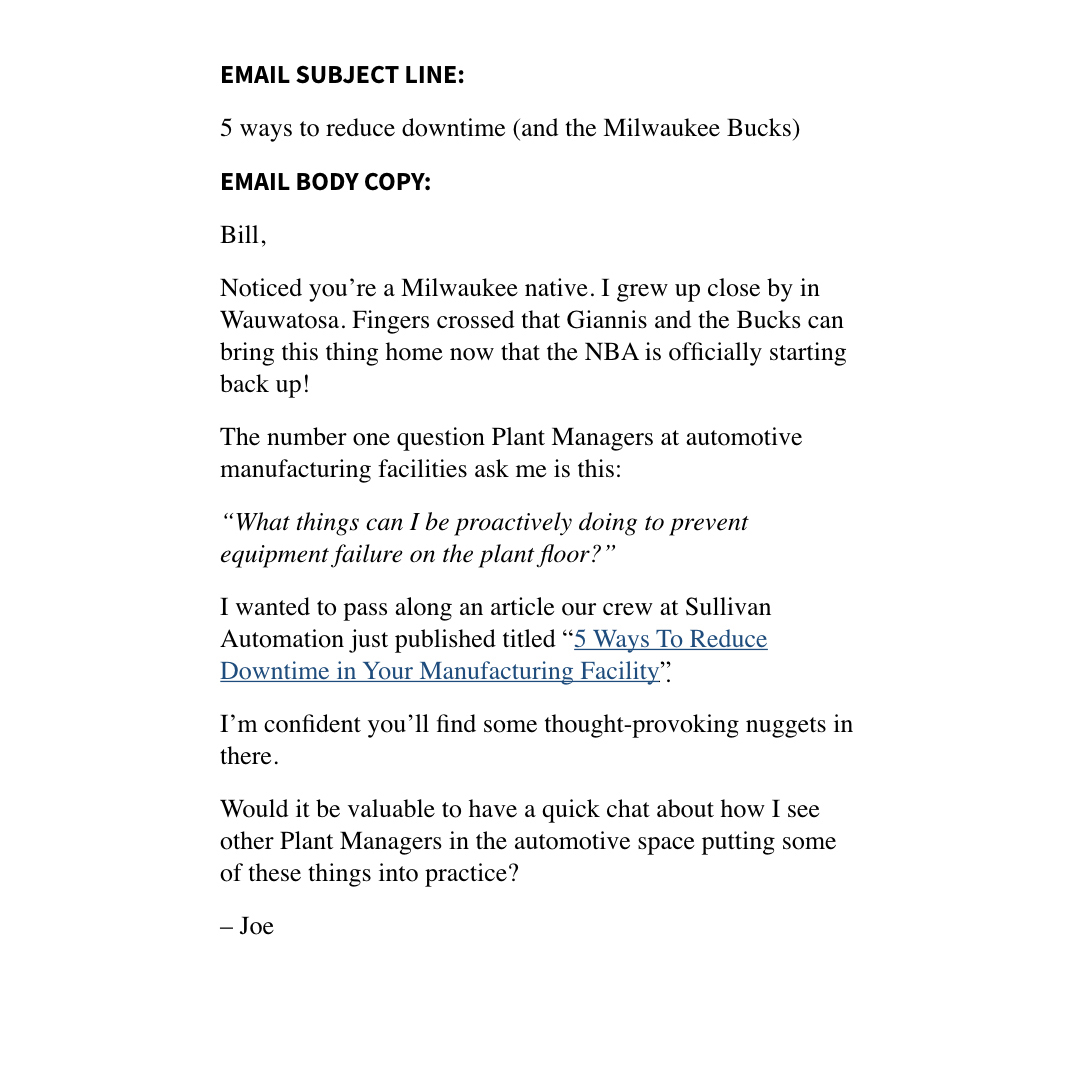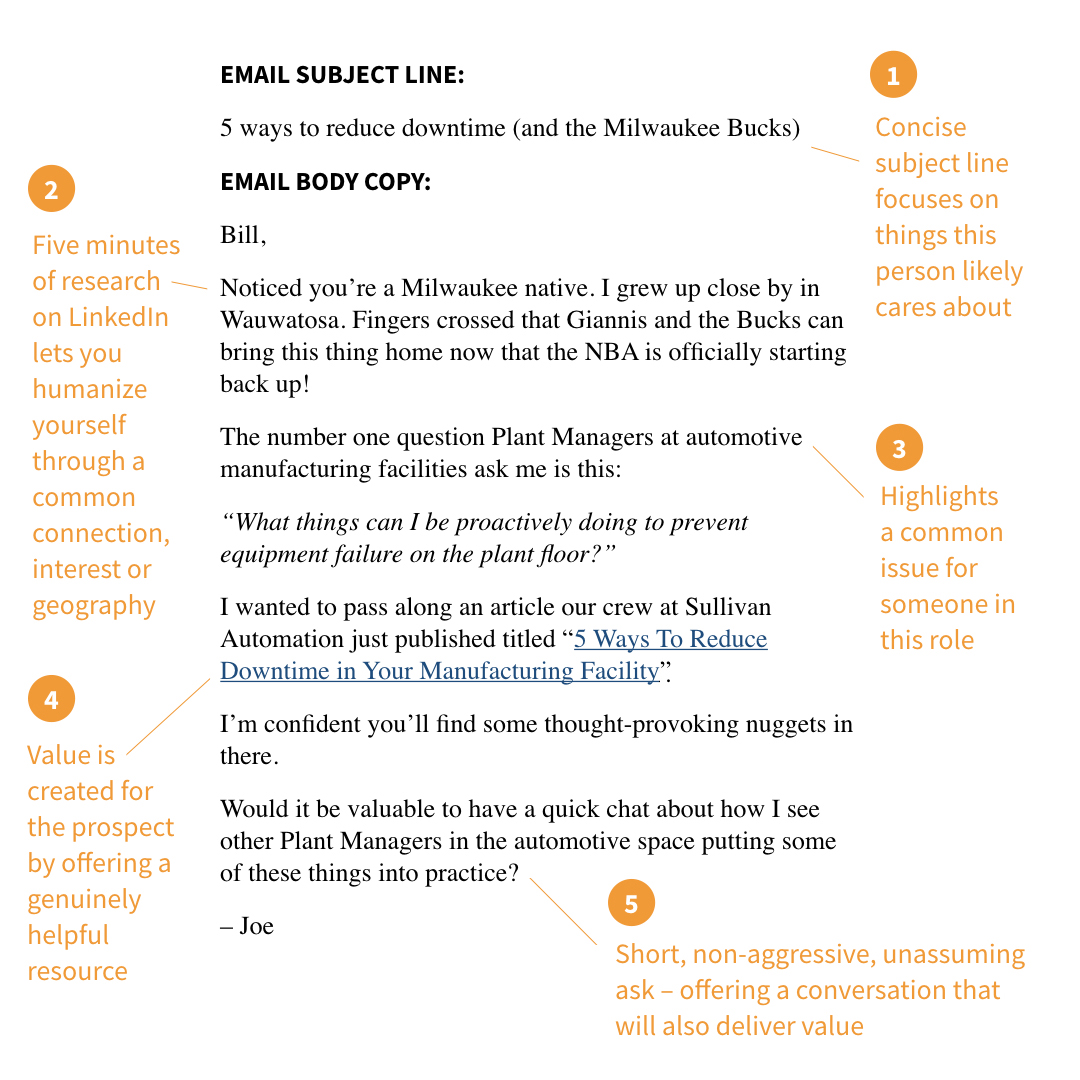
“We’re amazing. No one out there has products, solutions, people or customer service like ours. Here’s a list of all the stuff we sell. I’m sure you must need at least one of those things (if not all). So make sure you answer when I call you to talk about placing a PO on Friday at 4 p.m.”
Boiled down to its essence, this is what the typical sales prospecting email communicates.
Sure, it’s usually softened up with some cute fluffy stuff like…
“I came across your website and noticed you’re in an industry we serve.”
No kidding?! I’m all ears. You totally had me at “I came across your website.”
Or…
“I hope you’ve having a fantastic day and that your year is off to a great start!”
How kind of you to be thinking about me of all people today! You’re not about to try selling me something are you? And actually, it’s June now, so you might want to update your template to say “…and that your summer is off to a great start.”
Delete.
Unsubscribe.
Mark as spam.
Please remove me from your list.
I say it all the time, but no one cares about you or me. At least not yet. They care about themselves, their problems and the things they’re trying to achieve.
So what’s with all the transactional “me, me, me” emails? What makes us think a recipient actually welcomes these in their inboxes?
Who taught us to operate this way in the first place?
And why do we keep doing it time after time even though it’s not working?
So if not that, then what?
When I consult a B2B manufacturing organization about their sales and marketing strategies, one of the first things I look at is how they’re communicating with prospects.
And most of what I find resembles the first paragraph of this article.
Lots of “me.” Very little “you.”
We need to start with a mindset shift – from focusing on ourselves to focusing on the prospect.
This means identifying with what matters to them, making personal connections when possible, showing empathy and talking like a real human being.
It also means acknowledging the fact that nobody’s buying anything on the first (or probably second, third or fourth) touchpoint.
Most of the manufacturers we work with sell big-ticket items. Long sales cycles. Complex buying processes. Committees of buyers (engineers, plant managers, operations folks, procurement, C-suite, etc).
Take a moment to consider the way you making big purchasing decisions in your personal life. You don’t buy a house on a whim. Or a new car. Or even a computer.
And just the same, your prospects don’t make $100,000-plus capital expenditures with some guy or gal that just dropped a cold “we sell spectacular machines to people like you!” message into their inboxes.
This isn’t a transactional sale. It’s a process of building trust, educating the buyer and helping guide them to the right solution.
So let’s align our outbound messaging to how they actually buy.
Dissecting your typical prospecting email
I want to make this actionable for you.
So here’s what we’re gonna do next:
- We’ll start with a typical prospecting email and break it down. We’ll look at what’s wrong with it and why it’ll get a lot more unsubscribes than replies.
- Then we’ll rewrite it, dissecting the elements that’ll make it work.
- And finally, I’ll leave you with some working starter scripts in a Google Doc that you can download, edit and deploy however you see fit.
OK, let’s do this.
Here’s the typical prospecting email:

Sound familiar?
Maybe it looks like some emails in your own outbox. It almost certainly looks like quite a few in your inbox.
So now let’s dissect it.

I want to expand a little bit on the five points highlighted here.
- Point #1. This subject line is lonnnnnnnnng. Less is more in this case, so keep it to 50-60 characters (most email software won’t show more than that in your inbox list anyway). It’s also REALLY LOUD!!!!!!!! Let’s take it easy on the all caps and exclamation marks. Finally (and worst of all) it’s all about the sender – not the recipient. You’ve got a few words to convince your prospect to open this email. If they don’t, it doesn’t matter what’s in the body copy because they’ll never see it anyway.
- Point #2. This email dives straight into a pitch. We’re the best. Here’s what we do. Blah, blah, blah. No one cares.
- Point #3. When you say that you “specialize” in 10 or 20 different things, you’re actually communicating the exact opposite. “Maybe if I just list a bunch of things we’ve done before, something will catch their attention”.
- Point #4. There are literally hundreds of thousands of companies that could copy and paste this exact sentence into their email. After all, who would tell you they don’t strive to achieve customer satisfaction with amazing service?
No one believes this kind of fluff until you’ve had the chance to prove it anyway. So leave out the wasted words.
- Point #5. Request a quote? I don’t even know who you are! The good news here as that most recipients won’t read this line since they’ll have already deleted the email.
What an effective prospecting email looks like (and why)
Now that you’ve seen what not to do, let’s rewrite this thing.
First, read this clean. Then we’ll break it down.

Can you feel the difference between this email and the first one?
Let’s analyze it:

Let’s expand a bit on the five points from this revised email:
- Point #1. In just nine words, we demonstrated this is not a canned email. Both personally and professionally, we touched on things that are likely a part of this particular individual’s world. And we also implied that we’re offering some form of value inside the email. It’s worth opening to see what’s in there.
- Point #2. Not Google searching “person’s name” + “company name” + “LinkedIn” is just plain lazy. It’s so incredibly easy to do a little bit of research on your prospects today. See what you can learn about them and whether there’s any common ground to help you make a human-to-human connection (a person you’re both connected to, an organization you both follow, a place you’ve both lived, etc). If there’s nothing there, don’t force it. But at least take a few moments to explore.
- Point #3. Forget the fluff. They don’t need to hear who you are and all the things your company does. Get to what matters to them as quickly as you can. What common problems do people with this job title from this type of company run into from your experience? What questions do you hear from them time and time again on sales calls? Highlight the pain they may be experiencing or the goal they’re likely trying to achieve.
- Point #4. You don’t need 100 pieces of content on your website for this person. But you do need at least a few in your back pocket to get started. If content marketing isn’t your company’s bread and butter (yet), then bookmark this, and this and this for later. When you or your company has published insights that tackle those common problems and questions head on, objectively and with the pure intention of being helpful, you accomplish a few things: 1. You create value 2. You demonstrate that you’ve seen these issues before (which builds confidence) 3. You create engagement with this customer before they’re ready to talk to you.
- Point #5. Finally, the call to action is safe for the prospect. You’re offering more value and also piquing interest by mentioned what their competitors might be doing.
So there you have it. This approach has worked for us. It’s worked for our manufacturing clients. And there’s no reason you can’t put it to use inside your organization.
I dropped the starter script above into a working Google Doc for you (Prospecting Email Starter Scripts), and added a follow-up email template as well. Use them as you see fit. And if you do – please shoot me some feedback to let me how they’re working.
If you could use some more hands-on guidance, we’re currently booking private remote workshops to help you develop your online prospecting strategy. See below.
Regardless, hope this helps and best of luck getting started!


